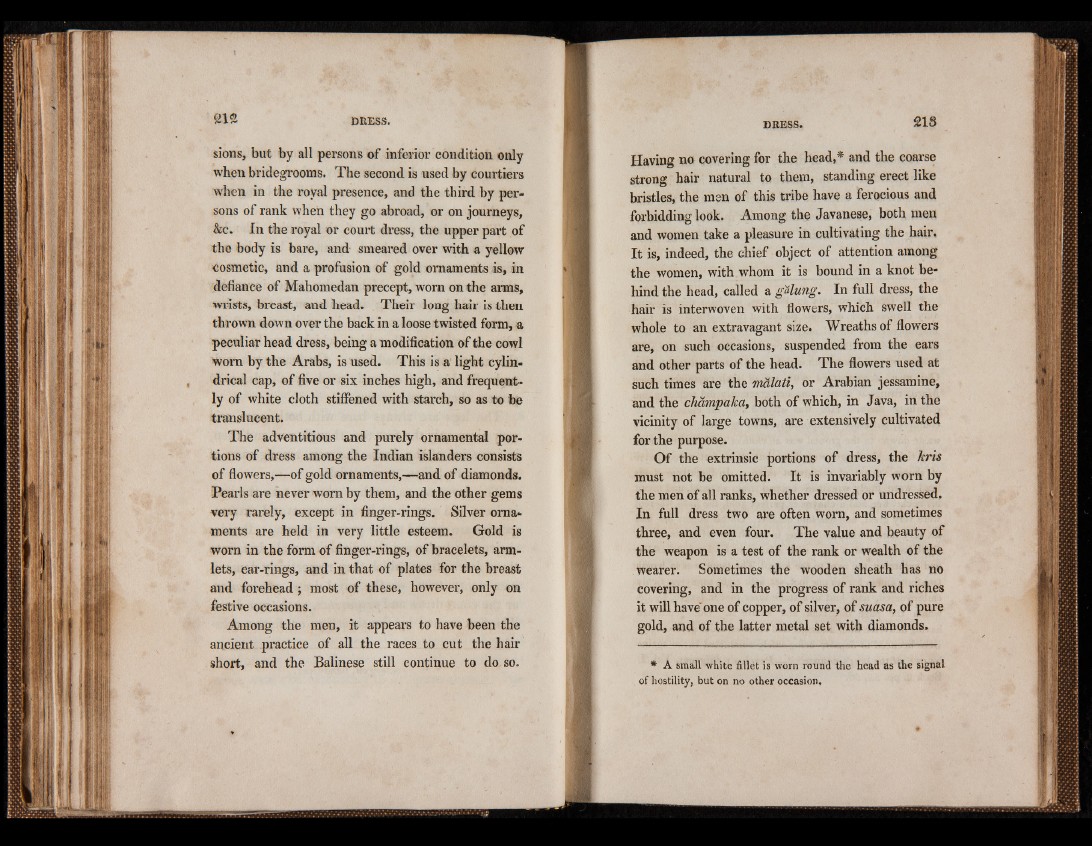
sions, but by all persons of inferior condition only
when bridegrooms. The second is used by courtiers
when in the royal presence, and the third by persons
of rank when they go abroad, or on journeys,
&c. In the royal or court dress, the upper part of
the body is bare, and smeared over with a yellow
cosmetic, and a profusion of gold ornaments is, in
defiance of Mahomedan precept, worn on the aims,
wrists, breast, and head. Their long hair is then
thrown down over the back in a loose twisted form, a
peculiar head dress, being a modification of the cowl
worn by the Arabs, is used. This is a light cylindrical
cap, of five or six inches high, and frequent ly
of white cloth stiffened with starch, so as to be
translucent.
The adventitious and purely ornamental portions
of dress among the Indian islanders consists
of flowers,—of gold ornaments,—and of diamonds.
Pearls are never worn by them, and the other gems
very rarely, except in finger-rings. Silver ornaments
are held in very little esteem. Gold is
worn in the form of finger-rings, of bracelets, armlets,
ear-rings, and in that of plates for the breast
and forehead; most of these, however, only on
festive occasions.
Among the men, it appears to have been the
ancient practice of all the races to cut the hair
short, and the Balinese still continue to do so.
Having no covering for the head,* and the coarse
strong hair natural to them, standing erect like
bristles, the men of this tribe have a ferocious and
forbidding look. Among the Javanese, both men
and women take a pleasure in cultivating the hair.
It is, indeed, the chief object of attention among
the women, with whom it is bound in a knot behind
the head, called a galung. In full dress, the
hair is interwoven with flowers, which swell the
whole to an extravagant size. Wreaths of flowers
are, on such occasions, suspended from the ears
and other parts of the head. The flowers used at
such times are the mdlati, or Arabian jessamine,
and the champaka, both of which, in Java, in the
vicinity of large towns, are extensively cultivated
for the purpose.
Of the extrinsic portions of dress, the kris
must not be omitted. It is invariably worn by
the men of all ranks, whether dressed or undressed.
In full dress two are often worn, and sometimes
three, and even four. The value and beauty of
the weapon is a test of the rank or wealth of the
wearer. Sometimes the wooden sheath has no
covering, and in the progress of rank and riches
it will have one of copper, of silver, of suasa, of pure
gold, and of the latter metal set with diamonds.
* A small white fillet is worn round the head as the signal
of hostility, but on no other occasion.